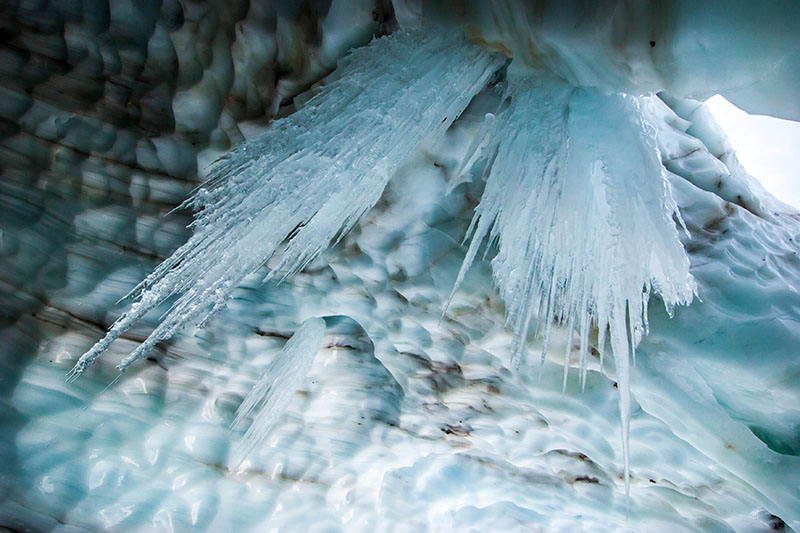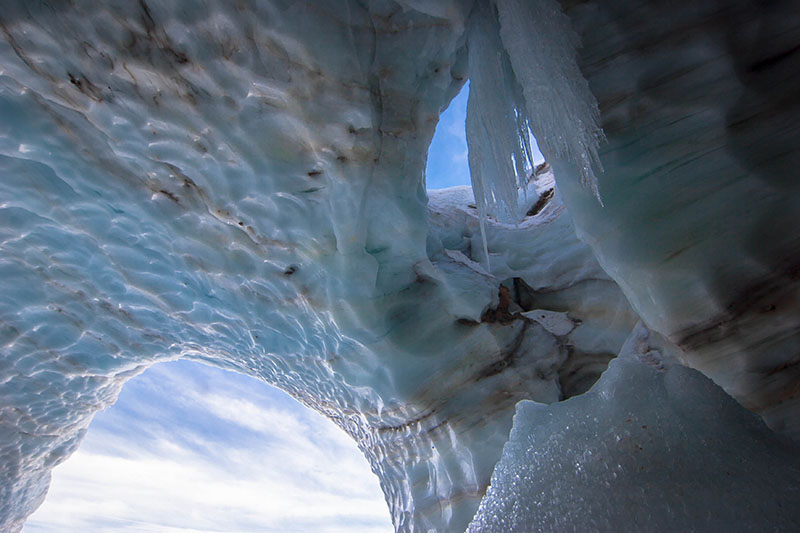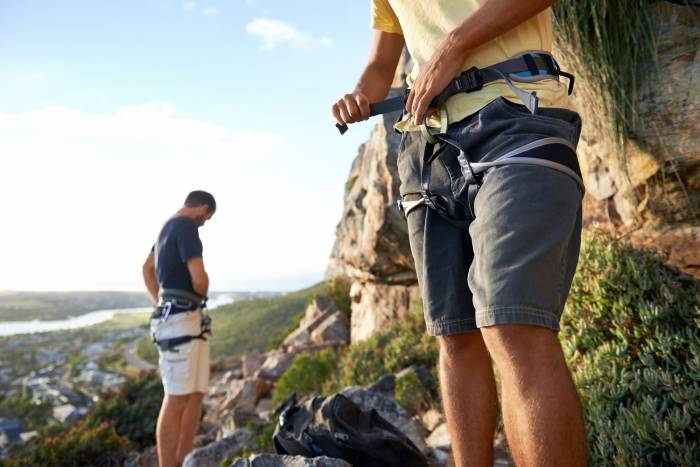The author warns that no amount of precaution can make exploring in or around these dynamic glacial caves entirely safe. Besides the standard risks associated with glacier travel, risks surrounding the caves include unpredictable falling rock and ice, which were responsible for a fatality this year, and flash flooding when large pockets of water burst through the cave walls. Additionally, communication to the surface is blocked by the glacier, so it may be impossible to call for help in the case of an injury. If you decide to explore these caves or others like them, you do so at your own risk.

By Jeff Kish
Through most of the protracted Pacific Northwest winter, the Cascades are shrouded in thick clouds and relentlessly blasted with snow and ice. Unpredictable weather patterns and unstable snow keep all but the most hardy from ascending into their upper reaches much of the time; but brief respites do occur and offer a unique alternative to summer climbing. I recently saw favorable reports for Oregon’s tallest peak and seized the opportunity to explore something new: the largest known glacial cave system in the contiguous United States.

I left the city for Mount Hood just after sunset, and when I turned off the highway onto a narrow forest service road, the asphalt quickly gave way to snow and I had to follow a single set of deep ruts left in the ice by a 4×4 that had come through when the snow was still fresh. After half an hour of white-knuckle driving, I cut the steering wheel hard to hop out of the ruts, and wedged my Econoline out of harm’s way near a buried trail head.

I packed my gear, set my alarm for 3:30 am, and went to bed listening to the frozen winds howling through the surrounding firs.
I slept well and kept warm, wrapped in a tangle of wool and down, but when I woke in the morning and popped my head out from under the blankets, I saw that the humidity from my breath had condensed and frozen onto the few uninsulated bits of my glass and steel den, and I repeatedly hit snooze as I built the gumption to emerge from my nest of bedding.

I spent the predawn hours ascending the mountain on a network of icy trails under a canopy of old growth by headlamp, and reached a clearing in the trees just as the sun breached the southern ridge of the canyon and exposed my destination. There’s no established route to these caves even when the snow has melted and the ground around the glacier is exposed to summer sun, so when I gained sight of the cave opening, I broke from the trail system and traversed directly across the canyon’s northern wall.
After several ankle-straining hours of traversing across 35° to 45° ice on crampons, I reached the lower entrance to the cave known as Snow Dragon.

I quickly passed through the unstable opening into the cave system, hopping over large chunks of ice and rock that had previously fallen from the roof above. Further in, evidence of ice and rockfall diminished, and I set down my pack to begin photographing the interior.

According to an extensive report, the caves were only first discovered in the last 10 years and surveyed in the last two, and offer a unique glimpse into the internal destruction of a glacier in it’s receding phase.
Experts predict the caves will disappear in the not-so-distant future as the glacier continues to shrink; and the precedent set by the Paradise cave system that once existed on Mount Rainier suggests that this may be a unique and preciously limited opportunity to explore and document such a phenomena.

Inside, I found the water cascading down the cave’s floor to be warmer than I would have expected, especially with fresh snow piled high on the glacier and the thickness of the icy crust on the way up.
I’ve seen volcanic gas venting off other parts of the mountain and wonder if this trickle is similarly heated from below. I scoop some up to drink and think about the path that gravity will guide the rest; into the Sandy river, where I sometimes fish for salmon down below.

The walls of the cave are smooth and contoured like chipped glass, taking on blues and greens where the light filters through, which is contrasted by the rusty striations of dirt that once fell or blew onto the glacier’s surface and over time, worked it’s way down through; recording the year’s events in a single line like the rings of a tree.

Similarly, history is written all over the ceiling. A few large boulders hang half exposed, 20 feet overhead. They must have fallen from the cliffs above and came barreling down the mountain before coming to rest in the soft summer snow atop the glacier a long time ago.
I wonder how long they’d been there, and how much longer it would be before they dropped and joined the rest underfoot.

After I was finished probing around this otherworldly landscape, I descended the mountain in much the same way I had come up, and lost a race against the setting sun. When I returned to the van, it took a few minutes of rocking back and forth to free it from the drift, but the deep ruts in the icy road were frozen solid and steered me down the mountain like rails guide a train.

—Jeff Kish’s weekly column is written on a laptop aboard the customized Ford Econoline in which he lives. You can catch up on Kish’s past stories: The Rubber Tramp Diary, Entry One, and his back story about shuttling through-hikers.







